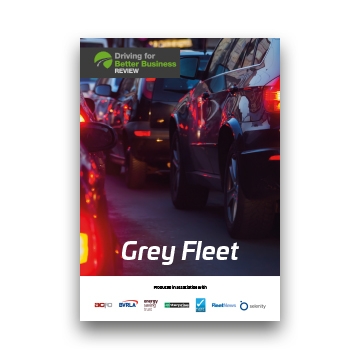Driving for Better Business has just launched its new Grey Fleet Review – the first of what will be a series of in-depth reviews into topics that can have a significant effect on both the risk profile and the operational costs of any organisation.
The first – on grey fleet – looks at the 14 million private vehicles used for business on the nation’s roads
Delivering fresh analysis of the disadvantages – as well as some of the advantages – of privately-owned cars being used for work in the public and private sectors, the review is an invaluable guide for leaders, fleet managers and policy-makers.
Delivering fresh analysis of the disadvantages – as well as some of the advantages – of privately-owned cars being used for work in the public and private sectors, the review is an invaluable guide for leaders, fleet managers, drivers and policy-makers.
In our Grey Fleet Review, Driving for Better Business:
- Examines viable grey fleet alternatives including cutting edge ‘mobility’ policies,
- Exposes the cost of grey fleet to the environment and to businesses’ bottom line,
- Reports on how grey fleet drivers often ignore basic vehicle safety checks,
- Reveals how organisations have slashed costs by ditching grey fleet, and
- Explains why grey fleet can be bad for employers and employees.
‘Grey Fleet’ reports that at least 12 billion miles are still being driven annually on Britain’s roads each year by grey fleet vehicles, sometimes at a high cost to the environment. It reports that mileage driven in the private sector alone generates up to 3.2 million tonnes of CO2 per year.
Experts explain how a modern ‘mobility’ approach can enable employers to reduce dependency on grey fleet, by using business car clubs, car rental or even public transport for essential work trips instead. The review reports on how the average age of a grey fleet vehicle is eight years or more compared to a one and a half years for a lease vehicle, or 1.3 years for a salary sacrifice vehicle.
‘Grey Fleet’ also outlines duty-of-care and liability dangers for businesses running grey fleet vehicles without proper policies and checks in place – and how employees can be caught out financially if they fail to do the sums.
The grey fleet has long been a matter of considerable concern to those involved in managing work-related road risk, but it needs greater attention, as it has the potential to affect businesses from the top down.
There is no doubt that grey fleet has a role to play in keeping the wheels of industry and the public sector turning. But, as we show, this comes at a cost. Is grey fleet still a viable solution or should we be looking to replace it in the 21st century?
Authoritative contributors to Grey Fleet include John Pryor, chair of ACFO. He predicts that grey fleet will continue to grow – but argues forcefully why fleets should increasingly look towards ‘Mobility’ solutions instead.
The publication also brings the authoritative Getting to Grips with Grey Fleet report – published by the Energy Saving Trust and the British Vehicle Rental and Leasing Association (BVRLA) in 2016 – up to date, with both those organisations looking at how the emphasis on grey fleet has changed since the report was published.
The publication also examines the most effective ways to better manage the risk of grey fleet, including a look at how rental specialist Enterprise helps clients with bespoke car clubs and short-term rental solutions, outlines the thoughts of leading DfBB Business Champions on the subject, and explains why ‘cash allowance’ means companies are losing an element of control that is vital for monitoring safety, emissions and compliance.
Our Grey Fleet Review contains the following articles:
John Prior – Chair, ACFO
A new word has entered our lexicon and it is ‘Mobility’
Simon Turner – Campaign Manager, Driving for Better Business
Has Britain begun to change its travel habits? Does grey fleet have a future?
Stephen Briers – Editor-in-Chief, Fleet News
Far too few companies manage their grey fleet drivers adequately.
Can You Really Ditch Your Grey Fleet?
Enterprise show how it could save you time and reduce both costs and emissions.
On a Wing and a Prayer
Research shows that grey fleet drivers across Europe are not undertaking basic vehicle maintenance.
New BVRLA strategy to address grey fleet problem
Excessive costs and emissions means grey fleet is an issue that needs to move with the times.
Out of Control
Companies are losing essential controls for monitoring safety, emissions and compliance.
Why your true grey fleet may be bigger than you think
Many businesses with active grey fleets simply do not realise the level of responsibility they have.
1 in 5 Drivers Fail Insurance Checks
Expenses experts Selenity found 21% of grey fleet drivers are failing insurance checks and may not be eligible to drive for work purposes.
How do our Champions manage Grey Fleet?
Examples of how a selection of our Driving for Better Business Champions manage their grey fleet.
Go here for the Driving for Better Business Grey Fleet Review






